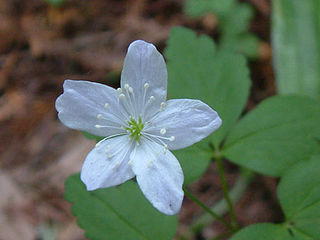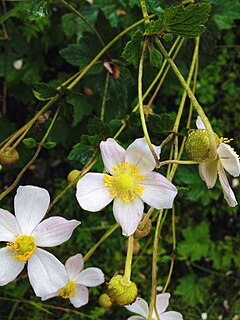Anemone is a genus of flowering plants in the buttercup family Ranunculaceae.
Contents
Anemone may also refer to:
Anemone is a genus of flowering plants in the buttercup family Ranunculaceae.
Anemone may also refer to:

Anemone is a genus of flowering plants in the buttercup family Ranunculaceae. Plants of the genus are commonly called windflowers. They are native to the temperate and subtropical regions of all continents except Australia, New Zealand and Antarctica. The genus is closely related to several other genera including Anemonoides, Anemonastrum, Hepatica, and Pulsatilla. Some botanists include these genera within Anemone.

Ranunculales is an order of flowering plants. Of necessity it contains the family Ranunculaceae, the buttercup family, because the name of the order is based on the name of a genus in that family. Ranunculales belongs to a paraphyletic group known as the basal eudicots. It is the most basal clade in this group; in other words, it is sister to the remaining eudicots. Widely known members include poppies, barberries, hellebores, and buttercups.

Ranunculaceae is a family of over 2,000 known species of flowering plants in 43 genera, distributed worldwide.

Ranunculus is a large genus of about 600 species of flowering plants in the family Ranunculaceae. Members of the genus are known as buttercups, spearworts and water crowfoots.

Anemonoides nemorosa, the wood anemone, is an early-spring flowering plant in the buttercup family Ranunculaceae, native to Europe. Other common names include windflower, European thimbleweed, and smell fox, an allusion to the musky smell of the leaves. It is a perennial herbaceous plant growing 5–15 cm (2–6 in) tall.
Windflower may refer to:
The phrase wood anemone is used in common names for several closely related species of flowering plants in genus Anemonoides, including:

Anemonoides quinquefolia, a flowering plant in the buttercup family Ranunculaceae, is native to North America. It is commonly called wood anemone or windflower, not to be confused with Anemonoides nemorosa, a closely related European species also known by these common names. The specific epithet quinquefolia means "five-leaved", which is a misnomer since each leaf has just three leaflets. A plant typically has a single, small white flower with 5 sepals.

Anemone hepatica, the common hepatica, liverwort, kidneywort, or pennywort, is a species of flowering plant in the buttercup family Ranunculaceae, native to woodland in temperate regions of the Northern Hemisphere. This herbaceous perennial grows from a rhizome.

Anemonoides lancifolia, the lanceleaf anemone or mountain thimbleweed, is an herbaceous plant species in the family Ranunculaceae. Plants grow 20 to 30 cm tall, growing from a horizontally orientated rhizome, flowering mid spring to early summer. The flowers have white sepals that are 12–20 mm long. This species much resembles Anemonoides quinquefolia, of which it was formerly considered a subspecies, except that it is larger growing. After flowering fruits called achenes are formed in a small cluster, each achene is 3.5–5 mm long, lacks wings and has a straight or partly curved beak that is 1–1.5 mm long.

Anemone hortensis, commonly called broad-leaved anemone, is a perennial herbaceous flowering plant with an underground rhizome, in buttercup family Ranunculaceae. The genus name comes from the Greek ἄνεμος, as an ancient legend tells that the flowers open only when the wind blows. The species name hortensis refers to the easiness with which this plant can be cultivated.

Anemonoides is a genus of flowering plants in the buttercup family Ranunculaceae. Plants of the genus are native to the temperate regions of the Northern Hemisphere, on the continents of North America, Europe, and Asia. The generic name Anemonoides means "anemone-like",, a reminder that many of the species were formerly included within the genus Anemone.

Anemone drummondii is a species of flowering plant in the buttercup family Ranunculaceae, known by the common name Drummond's anemone. This wildflower is native to western North America from California to Alaska. It is a squat perennial with short erect stems and small, soft, wrinkled leaves. Each clumping plant produces several showy flowers, each with five to eight petal-like sepals but no petals. The sepals are usually white, often with a distinct blue tint. The flower center is filled with many yellow-anthered stamens. The fruits are woolly achenes. This is a plant of mountainous environments such as the Cascade Range and Sierra Nevada, extending from the coniferous forests to alpine elevations.

Anemonoides oregana is a species of flowering plant in the buttercup family known by the common names blue windflower, Oregon anemone, and western wood anemone. It is native to the forests of Washington, Oregon, and northern California in western North America, generally below 7,000 feet (2,100 m) elevation.

Anemonoides blanda, syn. Anemone blanda, the Balkan anemone, Grecian windflower, or winter windflower, is a species of flowering plant in the family Ranunculaceae. The species is native to southeastern Europe and the Middle East. The specific epithet blanda means "mild" or "charming". The genus name is derived from the Greek word anemos, or wind.

Anemonastrum is a genus of flowering plants in the buttercup family Ranunculaceae. Plants of the genus are native to the temperate and subarctic regions of North America, Greenland, Europe, Asia, South America, and New Zealand. The generic name Anemonastrum means "somewhat like anemone", a reference to the Anemone genus of closely related plants. It chiefly differs from Anemone in having a base chromosome number of x=7, as opposed to x=8.

Eriocapitella vitifolia, a species of flowering plant in the buttercup family Ranunculaceae, is native to Asia. The specific epithet vitifolia means "vine-leaved, with leaves resembling those of Vitis", the genus of grapevines, and so the plant is commonly called the grape-leaved anemone or grape-leaved windflower. In Chinese, a common name is ye mian hua, which means "wild cotton".

Eriocapitella tomentosa, a species of flowering plant in the buttercup family Ranunculaceae, is native to Asia. The specific epithet tomentosa means "thickly matted with hairs, tomentum (padding)". In Chinese, a common name is da huo cao (大火草), which means "big fire grass" or "great fireweed".
Eriocapitella rupicola, a species of flowering plant in the buttercup family Ranunculaceae, is native to Asia. The specific epithet rupicola means "growing on rocks". In Chinese, a common name is yan sheng yin lian hua, which means "rock anemone".